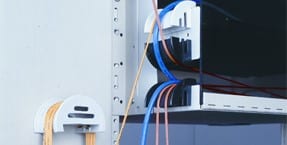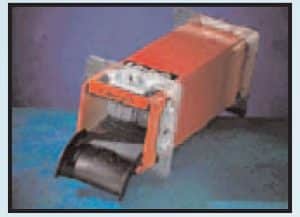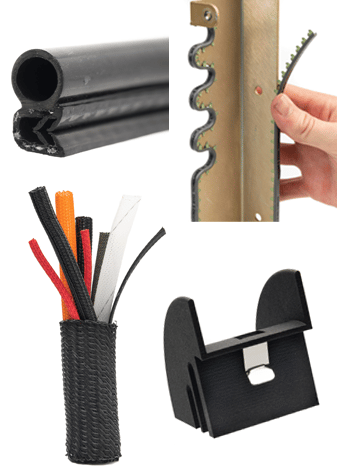Simple Wiring Problems Can Create Big Internal Issues?
What happens if there’s a kink in a fiber cable in a company’s server room?
What happens if a fiber cable coming through a wall conduit ‘snags’ and bends too far before it reaches a computer?
Slower download speeds? Lost data? Or worse — complete network failure?
Computer networks are the backbone of today’s data-driven business. Businesses need to transfer huge amounts of data and do this fast. These needs have transformed the way that networks are designed and installed and importantly shifted away from the standard copper-based to fiber optic cables.
Design engineers know that fiber cable management is a critical issue. If minimum bend radii of fiber optics are not properly maintained, signal integrity is lost, causing loss of data and possible catastrophes. DTi has a solution.

Suffering from the Bends
Fiber optic cables use light pulses to transmit information, whereas copper-based cables transmit electric pulses. Light transmissions are dramatically faster than electrical pulses and increase the amount of data that can be transmitted vs. copper.
However, fiber cables have a weakness. If a fiber cable is bent too sharply, the optical signal can be degraded or lost. Bending causes the signal to be reflected or refracted internally or it may literally fail to make the “turn” and hit the fiber cladding. Bending can also cause micro-cracking, which can permanently damage the individual fibers, especially during the pulling involved in most installations.
Typically, the greatest likelihood of damage occurs when the cable runs into or out of a server rack or through a conduit and needs to bend. Controlling that bend is critical.
An additional issue is that when fiber exits the cabinet, they invariably are routed over or through sheet metal panel edges. Over time, these sharp metal edges can cause abrasion, damage, and more data loss.
A Solution Wish List for Preventing Data Loss
To prevent these problems, the best solution must maintain the minimum bend radii of the fiber optic cable.
A number of specialty snap-in devices exist for routing fiber internally in a singular plane, including spools and service loops. Here is what we think design engineers might want to keep in mind:
- Multiple Mounting Possibilities — ideally a universal solution that mounts on sharp edges with a clip or screws.
- Flexible — adaptable for use horizontally and vertically.
- Configuration Flexibility — 90-degree drop-down as well as 180, and 360-degree service loops.
- Range of Sizing — size options are important so as to not limit usage in small spaces or high-load areas.
- Service Loop Configurable — useful for multiple cable/tubing support or for future system expansion.
- Control/Easy to Change — straps to secure fiber firmly in place to control and facilitate changes.
- Flame Retardant — must meet UL94V-0, Telcordia, or MIL-STD specs as cabinets are a potential ignition source.
DTi’s Fast-Drop® Radius Control Modules (RCMs) fit all these parameters.
DTi’s Fast-Drop RCM
DTi designs and manufactures RCMs and best-in-class grommet edging as well as multiple other solutions to protect, fasten and control wiring.
The Fast-Drop RCM was designed with a “perfect bend,” a precise 90-degree curve with a bend radius per BICSI recommended specifications, sufficient to provide the correct minimum bend for fiber for consistent reliable data transmission.
A key element to Fast-Drop's success is its speed of application in retrofits of existing racks for end users as well as being valuable for OEMs in developing new wiring-ready rack systems. Its fast effective clip system makes it simple and easy to install on any system while maintaining NEBS compliance with GR63 CORE requirements.
Retrofits are particularly challenging for IT professionals as newer switches, routers, and other related systems are frequently added to preexisting racks and data centers that may not have the routing guides prepared to ensure a fiber-friendly system. The Fast-Drop RCM solves that headache with a quick easy -and safe- installation on virtually any sheet metal surface.
RCM Array Panels
Other mounting options include DTi’s pre-assembled Fiber Array panels designed with multiple RCM units on a standard 19” rack mount bracket. Single-bracket array panels can help manage fiber in and out of simple low-density rack systems while multiple array panels can be oriented to create more complex high-density fiber management systems.
Imagine you are in your office – maybe it's an IT center or an ISP location and you have at a minimum telecom closets to handle. As happens frequently, a new “node’ has to be added to the existing system rack. It’s a new pizza box 1U high system that is an upgrade but there is no prepared recommended fiber routing organization guide or devices to help you.
DTi's fiber array panels – using a series of RCMs – and service loop (360) units can help you quickly and safely manage the new node using a standard 19” rack mounting bracket.
Multiple RCMs ganged in 2 or 4-piece units create versatile 180- or 360-degree return service loops.
Features
- Both the Fast-Drop RCMs and Fiber Array panels are readily available. Their fast installation helps resolve fiber network upgrades as well as OEM requirements without extensive tooling, lead time, and cost.
- RCMs and panels are manufactured with a reliable fire-retardant and impact-resistant UL94 V-0 poly-carbonate material, ensuring consistent data transmission.
- They can be mounted in three ways: with sheet metal tabs, screws, or zinc-plated carbon steel clips that quickly snap on any edge both horizontally and vertically.
- Optional hook-and-loop straps (also fire retardant to UL94V-2) secure cables in place.
Applications
Fast-Drop is widely used in data networking and telecom in applications like system patch panels, fiber interconnect panels switches, routers, multiplexers, and raceways.
DTi’s Fast-Drop RCMs are also well suited for medical liquid and gas management systems as it can prevent medical tubing from bending too tightly and cutting off liquid, vacuum, or oxygen supplies, which are obviously crucial during surgery, intensive care, and in recovery rooms.
To find out more about Radius Control Modules go here
Client Collaboration In Development
DTi modified its existing RCM in collaboration with Specified Technologies Inc. (STI), a client in NJ. They had the EZ-Path, a galvanized steel cable raceway designed for stopping fires. The raceway includes an intumescent compound that expands and seals around the cables when exposed to fire/heat.

The new variant which is fire-retardant and impact resistant incorporated a fastener for snapping the Fast-Drop RCM quickly into place — the result gave STI a more versatile and effective product to offer to its customers.

